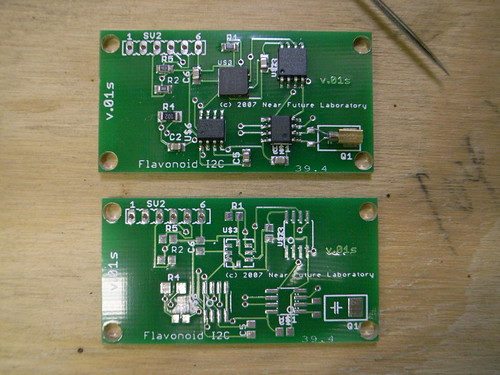This is another Flavonoid variation. I fear there are now becoming more than is reasonable to manage. Each one reflects a different design sensibility and a learn-through-practice approach. I decided to use the I2C protocol for many of the devices, largely to address the challenge of routing too many signals and in a bid to make the software more manageable. But, I sometimes get ahead of myself. My eagerness to send designs off to be manufactured sometimes has me skip some important considerations. In the case of this design here, I thought I could substitute the clock chip with another, which has the exact same pin-outs, only uses I2C versus SPI. I even prototyped with it. But, it turns out that it’s a 5 volt device, with no real leeway. Most of the other chips prefer a low-voltage in the range of 2-3.6 volts. So, basically — this real-time clock, the DS1307, is incompatible.
Back to the drawing board to find a replacement. Fortunately, I found a suitable chip, the DS1340, which has the exact same pinouts, is compatible with I2C and is happy as a fed pig at the 3 or 3.3 volts with which I plan to power the board. I should be able to hot-air the DS1307 off and replace it with the DS1340. We’ll see how that goes.
On this design, I also went with a surface mount crystal for the clock and tried working with a dual-axis accelerometer, but now I’m pretty much definitely of the mind that a tri-axis unit is the way to go.
I’ve been working at salvaging the LIS3LV02DQ tri-axis thing that cost me $15 a pop by trying my hand at hot-air rework. Here I popped the unit off and applied some flux to the thing, and then a warm solder iron. Like magic, it cleaned up and what looked like the perfect amount of solder magically adhered to each and every pin, clean as you like. This is what I should’ve done to begin with. Lesson learned. I reapplied it to the board and it looks like it attached just right. Unfortunately, the landing pad was a bit messed up with missing pads, but those were no-connects, so I might be okay.
Why do I want a tri-axis accelerometer? Well, my intuition is sort of guiding me here. This Durable Affinity design project is not concerned with the typical sort of meanings of precision (split-second, spot-on-accurate measurements of acceleration, etc.) I am curious how ambient precision can be used as a part of the interaction syntax. For instance, what sorts of interaction designs may arise when we take account of ambient movement, or ambient time — how much movement over the last 30 minutes, or has an hour passed or a few hours, and so forth.
Why do I blog this? Trying to create implications for my own work and keep track of what’s going on (and why it’s going on) in the Near Future Laboratory!


One thought on “Flavonoid v.01s Notes”
Comments are closed.